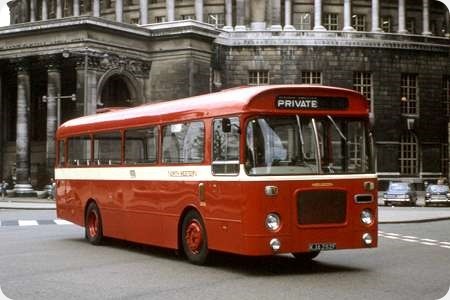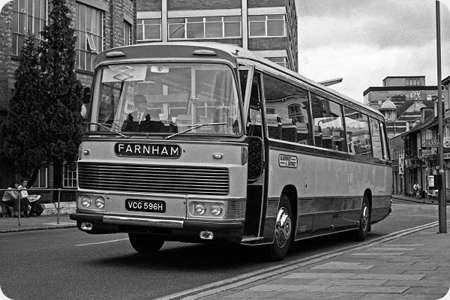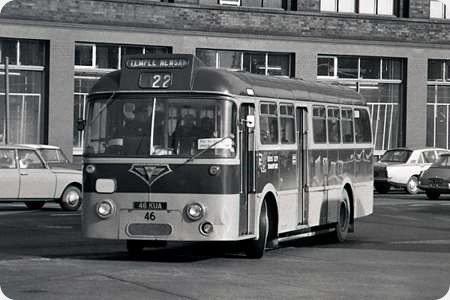
North Western Road Car
1968
Bristol RESL6G
Marshall B45F
In its final years, North Western chose the Bristol RE as its standard single deck bus chassis, initially selecting the shorter RESL6G version in 1968 before turning to the longer RELL6G variety from 1969 onwards. The RESL6G saloons numbered forty in total and all came with Marshall bodywork, the first fifteen, Nos 270-284, KJA 270-284F, arriving in January 1968 as B45F. However, Nos 285-309, KJA 285-289F, KJA 290- 309G delivered from July 1968 onwards, had the reduced capacity of B43F. On 1st January 1969 SELNEC PTE was formed, and much of the North Western stage carriage network lay within the designated SELNEC area. After lengthy negotiations, the National Bus Company conceded, and the hatchet finally fell upon North Western in January 1972 when its bus fleet was dismembered, leaving NWRCC as simply a coach operator. Most of the RESL/Marshall buses, including No 282 shown above, passed to SELNEC, but Nos 302 -309 were transferred to Crosville. I am sure that our Lancastrian contributors will be able to tell me the Manchester location of the photograph which was taken in June 1970. One final question – did these buses have Gardner LW or LX engines?
Photograph and Copy contributed by Roger Cox
18/11/18 – 10:41
This is unmistakably in St. Peter’s Square in Manchester and would have to be a tram to make such a manoeuvre now!
282 was one of the batch allocated to Oldham depot and was new in a livery that also had cream window surrounds and, distinctively, cream inside the peaks of the domes as can be seen on sister 281 here: https://davidbeilby
Although 281 survived long enough to get the SELNEC Cheshire fleetname as seen in the linked photo, 282 was repainted earlier as I have a picture of it in October 1970 in the above colour scheme. In your photo it seems to be newly-painted.
As it’s showing "PRIVATE" it doesn’t give much clue as to why it would be there and it may well be working from Manchester to Oldham depots after having been borrowed. It is also just possible, if it is a morning photograph, that it is returning from working the solitary morning peak journey from Mottram to Manchester Lower Mosley Street that was worked by Oldham – it worked out of service from Manchester back to Oldham depot.
David Beilby
20/11/18 – 09:11
It’s not early morning, David. At that point in my life I lived in Farnborough, Hampshire. I would catch an early train from London to undertake my Manchester transport jaunts, so it would be around midday or early afternoon.
Roger Cox
24/11/18 – 06:21
Well, at long last the NWRCC finally got its Bristols once again after more than 20 years.
The Central Library in the background of the photo looks far more impressive nowadays now it has been cleaned of all the grime that had accumulated prior to the Clean Air Act. I still have fond memories of the Library: there were many Saturday afternoons I would spend valuable learning time reading Buses Illustrated and Modern Tramway.
David Revis
24/11/18 – 09:56
North Western received its last Bristols, ordered prior to the effect of the nationalisation of Bristol, in late 1950 these being L5Gs 311-32 EDB 311-320 with Weymann B35R bodies. The RESL6Gs were delivered from January 1968, thus the wait for new Bristols was just 17 years, not over 20. Central Library was cleaned in 1971.
Phil Blinkhorn
25/11/18 – 06:51
The photo was taken in June 1970 and the bus looks freshly repainted. Could that explain why it is where it is? Would it have been repainted in Manchester?
Peter Williamson
15/04/19 – 07:13
To answer the question on engines, they had Gardner 6HLX engines. I have close personal experience of this, being the owner of the surviving member of the batch 299!
For obvious reasons I’ve collected a lot of photos of this batch, and I’ve found that quite a few were repainted from the ‘more cream’ style to the one we see here when quite young. My speculation (no more than that) is that the Marshall paint job wasn’t especially good, these bodies being built down to a price, and North Western gave them a repaint in the by-then current style when only about three years old.
To answer Peter Williamson’s question, it’s almost certain that it would have been repainted at the company’ Works at Charles Street in Stockport and could – conceivably – have been photographed on its way back to Oldham from the repaint.
Paul Williams
16/04/19 – 09:00
Travelling from Charles St to Oldham via St Peter’s Sq is a long way round. In 1970 the shortest route would have been Charles St-Bredbury-Denton-Ashton-Oldham.
Roger says the photo was taken mid day or early afternoon. There are a number of possibilities. David Beilby’s first suggestion; as we can’t determine the driver, some sort of engineer’s run though why go into Manchester?; if this was a Saturday (the lights are on in the library, so not a Sunday), returning from a private hire where the vehicle is not required for a return run, such as taking people from the Oldham area to an event at the close by Free Trade Hall that runs until late evening or returning from delivering people who have been visiting the Oldham area to wherever. Again, it could have run into Manchester as a duplicate on a trans Pennine service and was not required beyond Lower Mosley St or on the return. We’ll never know
Phil Blinkhorn
26/04/19 – 09:44
My own theory on why the bus is in Manchester is that having come out of the paintshop the driver may have been asked to deliver some urgent mail to Lower Mosley Street. It was common practice to send mail on service buses between depots. Oldham Depot only had two AM journeys that returned private back to Oldham. The first was a mentioned by David Beilby. The number 6 duplicate from Mottram. The other journey worked the service 503 from Adswood into the City. Prior to this journey it worked a journey from Ashton-under-Lyne to Hazel Grove (Mirrlees Works). Just a thought.
Keith Hampton
27/04/19 – 13:24
My father was one of the 116 workers entitled to use this service from the newly closed Ashton National Works to Mirrlees. At least in the early days this must have required 2 buses, perhaps one for works and a later one for offices. I presume the service ended at some point after most of the entitled moved or bought cars. Do you know how the return journey late afternoon was organised?
Tony Johnson
28/04/19 – 08:06
Thanks for explaining the origins of this Mirrlees works service. It’s pretty obvious now you mention it but not something I had thought about too much before.
There were two morning journeys from the information I have (which I think is the same that Keith Hampton has). It seems logical that there was an afternoon return service but this does not appear in the Oldham depot schedules, so one concludes it was worked by someone else. Either another North Western depot or another operator (jointly).
David Beilby
03/05/19 – 07:11
Tony Johnson mentions that at least 2 vehicles must have been required for this service.
I can confirm that this was the case, and both journeys were worked by Oldham Garage.
According to my list of Oldham duties:-
One Double Decker (Crew duty 23) departed Ashton Bus Station at 07:05, and a Single Decker (OMO duty 29) at 07:50.
On arrival at Mirrlees both buses then operated from Adswood to Chorlton Street.
Would it have been the case, do you think, that these 2 Adswood journeys would have operated to Lower Mosley Street before the closure of LMS? If that was the case then 282 was possibly heading back to Oldham after completing it work. There is no mention of PM journeys from Mirrlees in the Oldham duties.
Stephen Howarth
04/05/19 – 06:31
Stephen, the use of LMS is a distinct possibility.
Phil Blinkhorn
04/05/19 – 06:32
Unfortunately, Stephen, Roger has already pointed out that he would not have been in Manchester early enough for that to be the case.
I think that there were afternoon journeys but not worked by Oldham. I have a photograph of 932 on this service in April 1972 and that wasn’t an Oldham car at the time, but I don’t know to which depot it was allocated. It’s more likely to be an afternoon shot but I don’t actually know.
David Beilby



